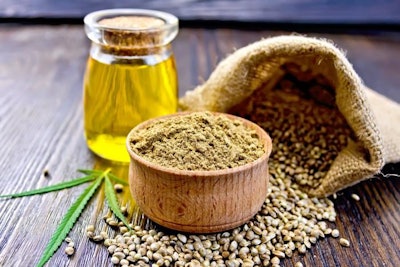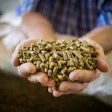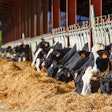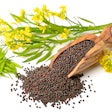
A look at the potential of hemp, hemp byproducts as an animal feed ingredient and the regulatory obstacles it faces
With high raw material costs and sustainability concerns, the demand for alternative feed ingredients — especially proteins — is at an all-time high. In the future, one plant may offer many solutions across all species: hemp.
The byproducts from the processing of hemp plants range from biomass to hemp seed oil, which is high in omega-3s. Widespread adoption of hemp and its byproducts in the United States has been stalled due regulations prohibiting its use in animal feed.
However, with the likelihood of hemp’s ability to scale up in the coming decades, animal feed producers may find a new ingredient with a valuable nutritional profile in hemp and its byproducts.
Morgan Tweet, co-founder and CEO of IND HEMP and the executive director of the Hemp Feed Coalition, joins the Chat to discuss the regulatory status of hemp in animal feed and to highlight some of its potential uses and how it may benefit food-producing animals.
Hemp, hemp byproducts as animal feed ingredients [VIDEO] from WATT Global Media on Vimeo.
Transcription of Feed Strategy Chat with Morgan Tweet, co-founder and CEO of IND Hemp and executive director of the Hemp Feed Coalition
Jackie Roembke, editor in chief, WATT Feed Brands/Feed Strategy: Hi, everyone. Welcome to Feed Strategy Chat. I’m your host, Jackie Roembke, editor in chief of WATT Feed Brands and Feed Strategy magazine.
This edition of Feed Strategy Chat is brought to you by WATT Global Media and FeedStrategy.com. FeedStrategy.com is your source for the latest news and leading-edge analysis of the global animal feed industry.
Today we’re joined on Zoom by Morgan Tweet, the co-founder and CEO of IND HEMP and the executive director of the Hemp Feed Coalition. She’s here to explore the potential of hemp and as byproducts as animal feed ingredients and the regulations slowing at us in the U.S. production.
Hi, Morgan. How are you today?
Morgan Tweet, co-founder and CEO of IND Hemp and the executive director of the Hemp Feed Coalition: I’m good, Jackie. Thanks for having me on here.
Roembke: Absolutely. Thanks. Well, let’s get right into it. Please provide an overview of the current U.S. regulatory status of hemp and its byproducts animal feed.
Tweet: Yeah, so a brief history is kind of hard to do but I’ll do my best. As you may or may not know, hemp seed products — so hemp hearts, hemp seed oil, hemp protein — does currently have GRAS status for human consumption. Basically we have the “generally recognized as safe” products, but that does not go over to the feed sector. Right now we do not have the ability to commercially sell hemp ingredients — whether that be CBD, hemp grain, hemp fiber, even — into those animal feed markets.
There are some states, including Montana, that have opened up markets and opportunities for specific ingredients and mostly specific species, e.g. the companion animals, exotic animals and equine are the markets that are open, and it is very similar to what Canada does. Canada is a really good example to look towards since they’ve been producing and marketing hemp ingredients for like the last 20 years. They really are a leader in the grain industry. And that really makes those ingredients make the most sense when you look at it from a feed opportunity. In Canada, they do have the companion animal and the equine markets open, but they also have regulations prohibiting sale in livestock or production animals.
It’s a giant hurdle for the industry, just because there are several co-products that would make a whole lot more sense in the feed market versus the human market. And that would just make all of our cost of goods a little bit easier and make us more competitive with other commodity markets that we’re trying to compete with.
Roembke: Excellent. Thank you so much for that history. Aside from the regulatory hurdles, do hemp advocates face any other challenges in bringing healthy ingredients to market?
Tweet: Yeah, so there’s a lot of just unknowns and lack of education. At the Hemp Feed Coalition, one of our missions is to advocate and educate. Cannabinoids are kind of the white elephant in the room because everyone’s really nervous about them. They’re not sure if they’re good, if they’re bad, what the levels are, which is understandable, right? We’re still learning a lot about it. But traditionally, and just the plant biology, those cannabinoids don’t naturally occur in the ingredients that we’re looking at and evaluating for feed.
I like to make sure that people understand that there’s really three different ways to harvest a hemp crop.
First of all, by the definition, hemp is a crop that is less than .3% THC that is sampled statewide and nationwide. You can harvest it for grain — so consider it like canola or flax, it’s very similar. You harvest it with the combine. Then those products include the hemp seed oil, hemp seed protein, hemp hearts and hulls. That’s one that I would say is the traditional way to make hemp products.
Then the alternative is growing for stock material. There’s not really a lot of feed value. There’s some research about early harvest stock material that may be good for silage. There’s a lot of cellulosic material there so there’s potential there. But it’s very early. And due to just the the hurdles we’re already seeing on the grain side, I think that it’ll be a while before we’re evaluating fiber products.
And then there’s the last way to harvest, which is harvesting floral material. From an agricultural perspective, floral production is much more akin to like tomato harvesting, right? It’s more horticulture than it is agriculture. And they’re, you know, growing on smaller acreages, it’s a different harvesting technique. You don’t want those plants to go to seed because you’re trying to harvest that those trichomes that are found on the bracts. So there are some tri-crop models that I don’t think it really has been fine tuned enough. I don’t know if there’s a feasibility for that in the industry in the future. But understanding that there’s three types of hemp production is key.
Then when you look at the nutritional opportunities, there’s a giant boom in 2019 and 2020 of CBD production and, because of that, a surplus of raw materials for the extraction guys, there’s a lot of this old biomass that’s out there. And that’s either it was extracted post-extracting material or flower material in general. And actually, it has a really intriguing nutritional profile, it looks pretty similar to alfalfa. There are some universities and companies that are evaluating that I know, Oregon State University has done a lot. So it’s interesting. But again, it’s pretty far behind, I think, on a regulatory pathway because it is higher concentrations of cannabinoids.
From a feed perspective, like, even if we did have regulations in favor for us to open the markets, I would think that feed formulators would still have that big question mark of how do you formulate with it. So I always stay focused on the oil seeds ingredients because people understand that, you know, they understand canola meal, they understand flaxseed meal, they know how to incorporate it into diets, whether it’s for ruminants or for poultry.
Obviously, it’s a higher fat content. But it also has a really great protein profile. So it has its unique amino acid profile that you’re going to find when you’re formulating with it. It has some of those amino acids you’re looking for. You may have to pair it, obviously, with some other ones; we’ve seen pea protein be another one that brings up some of those amino acids that may be lacking for formulation. But that’s pretty normal for all proteins, right? They have their distinct profile, and you find that there’s unique combinations.
I’ve heard it from a lot of researchers and formulators but what makes hemp so special is its great amount of healthy omegas. Even when you’re looking at a post-extracted or a post-pressed material where you’ve extruded that oil out as much as you can, you still have seven to 12% oil content. But that oil is what those good fats, right, the polyunsaturated fats that you’re looking for, high omega-3 content.
The markets with a lot of interest in this are aquaculture, right, they’re looking for an alternative for fish meal and they’re looking for this healthy omegas. The poultry industry is really intrigued by it, they’re also trying to incorporate more omegas into their finished egg products. And then the equine market is really intrigued because of the specific omegas that the grain ingredients bring to it.
I think we have to just educate the formulators and once we get them past that concern of, you know, is this a just a new material that has all these crazy compounds? And you understand that really, it is very unlikely that you’re going to be introducing any sort of compound that’s going to put any of your animals at risk and then you start evaluating it on its neutral nutritional potential, people get really excited about what they see for hemp.
Roembke: You alluded to some of these points, but based on the Hemp Feed Coalition’s recent research, what are the key benefits? How products can deliver to poultry and livestock rations?
Tweet: You can either go for a GRAS petition, both federally and state level, or you can go through a feed additive petition and that’s managed through AAFCO. Our first application was for hemp seed meal for laying hens.
We got to do a study where we were able to partner up with a great company out of Pennsylvania, Wenger Feeds, they were also working with Kreider. It was a great first application for us to see, like you said, the potential and the benefits that we see there.
I alluded to the omegas that we’re seeing, you know, go through the bird and make its way to the egg, which consumers are really excited for. Kreider has been able to make a market in Pennsylvania. They did go for a GRAS petition in the state and for over a year now they’ve been commercially selling hemp-fed eggs. The consumer really likes that, you know, you’re seeing slightly different color in the yolks, that’s, you know, intriguing to customers. I think they see that richer orange color, they like that. And then also a higher lutein content. I’m not a veterinarian or a formulator by any means or know much about poultry, but lutein is really kind of a cool compound that people are looking for for healthier eye development and other things, it’s something we we need to digest and have in our in our diets. So it’s cool to see that we can feed a bird an enriched hemp formulation and see those benefits in the egg.
Same thing on the ruminant side. There have been studies done in Canada and in Oregon on dairy cattle where you are seeing some of these omegas enriching the milk and the dairy products. It’s a lipid, it’s going to have those profiles, it’s going to follow along with some of those fats.
Ruminants are a really huge opportunity I think for the fiber as well. The hulls are another co-product when you make hemp hearts and we’ve seen a lot of dairy cattle and feedlots. It’s a better opportunity probably in earlier stages, it’s not necessarily a good finishing product, because we’re competing with DDGS and other finishing proteins. I think the niche opportunity is probably in like calf-cow operations so I think there is big opportunity with dairy.
We just need to get more research to see the benefits. There’s a researcher out of Canada that is really excited, hoping to see some potential, even with those added cannabinoids, that you may be able to enrich some of the feed to reduce the amount of vaccines and just making a healthier cow. I think all feedlots are concerned about that and looking for alternatives to a healthier herd.
Roembke: You’ve touched on a lot of points, but if you were going to stress one thing — so your No. 1 message that you would like to get across to U.S. producers and nutritionists — what would that be?
Tweet: Oh, man, just one thing? I think I’ve touched on a couple times but it’s one of those things that needs to be repeated. As you know, this is not a cannabinoid-rich product. And so to just dispel some of those fears and concerns with feed formulators, really just look at this like you would any oilseed meal product, or oilseed products in general.
Whether you’re incorporating the oil specifically or you’re using the meal or the protein, when people start to evaluate those opportunities, they see the potential. We believe it’s a powerhouse protein, but I don’t think there’s a single one diet that is going to be 100% hemp that’s going to be successful, right? You need to pair it with the right things for the species or whatever you’re working towards.
I think dispelling that kind of unknown about cannabinoids in hemp, and, you know, the “am I going to get my cow high?” Unfortunately, that’s still the conversation I have with people, you would think that after, you know, four-plus years of legality in the U.S. that we would be past that. These compounds are not putting your animals at risk. If anything, they’re providing a healthier diet, a healthier eating animal. So just trying to get them past that. It’s still an understanding thing, and I think people are getting there, but it is has giant opportunity.
As far as price point, once we get to it, it’s going to be challenging for the industry these beginning years because we just don’t have economies of scale to really support the price point that people are looking for. Corn and soybeans are the major players in animal feed products and we’re growing 9 million acres of soybeans and like 8 million acres of corn, and hemp, you know, we grew less than 50,000 acres last year. So there’s a huge discrepancy in scale there.
For us to compete on price point right now, it’s going to be challenging, and so that’s where we’re hoping to work with the formulators that understand that there is a value proposition here. There is something unique about these ingredients that you know they do drive a higher price point. While the industry continues to grow, farmers continue to learn how to incorporate this as a row crop. We can still be targeting some of those higher valued markets that see the potential and the return on on some of those ingredients.
Roembke: So for the feed industry stakeholders who are interested in learning more, where should they go?
Tweet: You can reach out to us, the Hemp Feed Coalition. We’re a small volunteer board. We try to do as much as we can. Probably half of us are part of the industry like myself — we have a great fiber operation — so there’s a lot of value for our business to see hemp be introduced as a feed ingredient, but the other half of our stakeholders are veterinarians, toxicologists, people in the analytical space, a lot of researchers because they do see the opportunity here, big ag.
In general, I think the U.S. is really at a turning point to change some things. We need to see more rotation crops, people want to have a little bit more diversified profile, so that when we see the volatility of agriculture, we can be a little bit more adept and nimble to do what’s best for our operations. Stakeholders at HFC have a really broad and diverse outlook on the ingredients in the applications. There are lots of people that we can connect you with, that’s kind of what we value is putting people in contact with each other.
Ultimately, our goal is to get federal approval. What does that look like? You know, do we have to continue to support research. We’ve helped fund several different trials, whether it be a lamb trial or a ruminant trial, we’ve, we’ve helped support those. Then, ultimately, we’d like to put either applications forward or support people who want to push for state policy. We’re big advocates of that, because, unfortunately, our bureaucratic process is very slow — and not just from hemp’s perspective. I think if you talk to anybody out there that is trying to get forth a new ingredient, it is an arduous process and, quite frankly, it needs to be revitalized.
We’re hoping in the upcoming Farm Bill that we can make that message clear that the current status quo is not working. If we’re trying to support domestic feed opportunities and domestic farmers so we don’t have to be relying on imports. We’re in a national feed shortage right now — we really should be having systems in place that encourage that growth and encourage entrepreneurs and new technologies, new ingredients.
Right now, that’s definitely not the case and so we’re trying to be an advocate for all feed ingredients that are trying to get through here, just that it’s an expedited process, and that we feel like our government is trying to support domestic businesses as we’re trying to support rural economies and the farmers that, really, at the end of the day, are getting the short end of the stick.
Roembke: Excellent. Thank you so much, Morgan. For more information and to keep tabs on updates related to hemp as a feed ingredient, please visit hempfeedcoalition.org.
Thanks again, Morgan. And thanks to you for tuning in.















